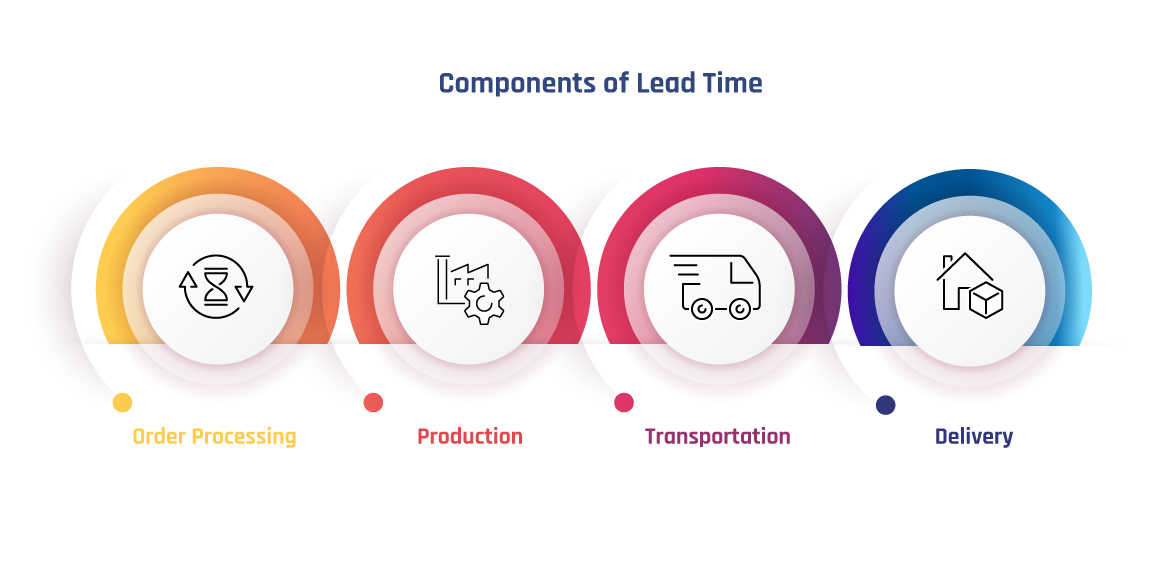
Navigating Supply Chain Disruptions in 2024: Strategies for Success
January 29, 2024
The Impact of Lead Time Variability on Supply Chain Performance: A DDMRP Perspective
February 16, 2024In today’s dynamic business landscape, optimising lead times in supply chain operations is paramount for staying competitive. With the increasing volatility in demand and supply, traditional supply chain models often struggle to maintain efficiency and meet customer expectations. However, a paradigm shift towards demand driven principles offers a solution to this challenge. Demand Driven Material Requirements Planning (DDMRP) has emerged as a game-changer, enabling organisations to enhance responsiveness, reduce lead times, and improve overall supply chain performance. This article explores how DDMRP principles can significantly reduce lead times in a demand driven environment, discussing key strategies and methodologies for achieving optimal results.
Understanding Lead Times
Before delving into the specifics of Demand Driven Material Requirements Planning (DDMRP), it’s crucial to have a clear understanding of lead times and their significance in supply chain management. Lead time is a fundamental concept that plays a pivotal role in determining the efficiency and effectiveness of supply chain operations.
Defining Lead Time
Lead time can be defined as the duration between the initiation of an order and its fulfilment. It encompasses various stages within the supply chain, including order processing, production, transportation, and delivery. Essentially, lead time represents the time it takes for goods or services to move from the point of order placement to the point of delivery to the customer.
Components of Lead Time
Lead time consists of several interconnected components, each of which contributes to the overall duration of the process:
Order Processing: The lead time begins with the initiation of an order, which involves activities such as order receipt, validation, and entry into the system. Efficient order processing is crucial for minimising lead times and ensuring timely order fulfilment.
Production: Once an order is received, it triggers the production process, where raw materials are transformed into finished goods. The duration of the production process significantly impacts lead times, with factors such as production capacity, resource availability, and process efficiency influencing production lead times.
Transportation: After production, the finished goods need to be transported from the manufacturing facility to distribution centres or directly to customers. Transportation lead times depend on factors such as distance, mode of transportation, carrier availability, and logistical constraints.
Delivery: This lead time involves preparation for the delivering the goods to the customer’s location. This includes activities such as order picking, packing, and shipping. Timely and accurate delivery is crucial for meeting customer expectations and maintaining customer satisfaction.
Quality: In many industries there may be a quality control and quality approval process that can take up from a few hours to several days. Depending on the circumstances it may be possible to run this time in parallel with transportation, but that is not always the case.

Significance of Lead Time Management
Efficient management of lead times is critical for several reasons:
Meeting Customer Demand Promptly: In today’s fast-paced business environment, customers expect quick turnaround times and prompt delivery of orders. Efficient lead time management enables organisations to meet customer demand promptly, enhancing customer satisfaction and loyalty.
Minimising Inventory Holding Costs: Long lead times often necessitate holding excess inventory to buffer against uncertainties such as supplier delays or transportation disruptions. However, excess inventory ties up capital and incurs carrying costs. By reducing lead times, organisations can minimise the need for excess inventory, thereby reducing inventory holding costs and improving cash flow.
Enhancing Operational Agility: Shorter lead times enhance the agility and responsiveness of supply chain operations. Organisations with shorter lead times can quickly adapt to changes in customer demand, market dynamics, and supply chain disruptions, gaining a competitive edge in the marketplace.
Challenges in Traditional Supply Chain Models
Traditional supply chain models, while once effective, often encounter various obstacles that impede their ability to optimise lead times effectively. These challenges not only hinder operational efficiency but also compromise customer satisfaction and overall supply chain performance.
1. Forecasting Errors
One of the primary challenges faced by traditional supply chain models is forecasting errors. Relying solely on demand forecasts can lead to inaccuracies, resulting in either excess inventory or stockouts. Forecasting is inherently complex, influenced by numerous factors such as market trends, consumer behaviour, and external variables like economic conditions or geopolitical events. Even with advanced forecasting techniques, inaccuracies are inevitable, leading to suboptimal inventory levels and longer lead times.

2. Bullwhip Effect
The bullwhip effect represents another significant challenge in traditional supply chains. This phenomenon occurs when fluctuations in demand amplify as they move upstream in the supply chain, leading to inefficiencies and longer lead times. As orders are passed from one stage of the supply chain to another, each participant tends to inflate the order quantities to account for uncertainty or to meet arbitrary targets. Consequently, these inflated orders create artificial demand spikes, exacerbating inventory imbalances and lead time variability.
3. Batch Processing
Traditional supply chain models often rely on batch processing, where large batch sizes and long production runs are common practices. While batch processing can yield economies of scale and lower production costs, it can also increase lead times and reduce flexibility. Long production runs may result in excessive work-in-process inventory and extended cycle times, leading to delays in order fulfilment and slower response to changes in demand.
4. Over Reliance on Safety Stock
Excessive reliance on safety stock to buffer against uncertainties is another challenge faced by traditional supply chain models. While safety stock is essential for mitigating supply chain disruptions and ensuring service levels, overreliance on safety stock can inflate inventory costs and lead times. Maintaining high levels of safety stock ties up capital and warehouse space, resulting in increased carrying costs and reduced operational agility.
5. Lack of Visibility
Inadequate visibility across the supply chain is a common challenge that impedes timely decision-making and responsiveness to changes in demand. Traditional supply chain models often lack real-time visibility into inventory levels, order status, and production schedules, making it difficult to anticipate and react to fluctuations in demand or supply disruptions. Without comprehensive visibility, organisations struggle to optimise lead times and meet customer expectations efficiently.
6. Lead Time Padding
Due to all the issues mentioned above, planners are incentivised to add some extra lead time days in their MRP planning system at every stage to protect themselves against potential problems. In doing so they create redundant safety and inflate the total lead time of the supply chain, which will then become inefficient “by design”.
The DDMRP Approach: Revolutionising Supply Chain Management
Demand Driven Material Requirements Planning (DDMRP) represents a paradigm shift in supply chain management, offering a departure from traditional forecast-driven planning methodologies. By emphasising the synchronisation of supply with actual demand signals, DDMRP enables organisations to enhance responsiveness, reduce lead times, and improve overall supply chain performance. At its core, DDMRP operates on five key principles that revolutionise the way organisations manage their inventory and production processes:
1. Demand Driven Planning
Traditional supply chain planning often relies heavily on demand forecasts, which are inherently uncertain and prone to inaccuracies. DDMRP, on the other hand, aligns inventory positioning and replenishment decisions with actual demand signals. By leveraging real-time data on customer orders, sales trends, and market demand, organisations can make more informed decisions about inventory levels and production schedules. This demand driven approach ensures that resources are allocated efficiently, minimising the risk of overstocking or stockouts.
2. Dynamic Buffer Management
Central to DDMRP is the concept of dynamic buffer management. Instead of maintaining fixed inventory levels, DDMRP dynamically adjusts buffer inventory based on demand variability, lead time fluctuations, and desired service levels. By continuously monitoring demand signals and adjusting buffer levels accordingly, organisations can optimise inventory levels to meet customer demand while minimising excess inventory and associated holding costs. This flexibility allows for greater agility in responding to changes in market conditions and customer preferences.

3. Decoupling Points
DDMRP recognizes the importance of decoupling points within the supply chain to mitigate the impact of demand variability and reduce lead times. Decoupling points serve as strategic buffers between different stages of production or distribution, allowing for more efficient resource allocation and production scheduling. By strategically placing decoupling points, organisations can isolate processes, reducing the ripple effects of demand fluctuations and minimising the risk of disruptions downstream.
4. Demand Driven Execution
Execution processes in a DDMRP environment are synchronised with demand signals to ensure timely and efficient order fulfilment. By aligning production schedules, material flow, and distribution activities with actual customer demand, organisations can minimise lead times and improve service levels. Real-time visibility into demand signals enables proactive decision-making, allowing organisations to prioritise orders based on urgency and optimise resource utilisation across the supply chain.
5. Continuous Improvement
DDMRP fosters a culture of continuous improvement through ongoing analysis, optimization, and adaptation to changing market conditions. By regularly monitoring key performance indicators (KPIs) such as lead times, inventory turns, and customer service levels, organisations can identify areas for improvement and implement corrective actions proactively. This iterative approach enables organisations to stay responsive to evolving customer needs, market trends, and competitive pressures, driving sustained performance improvement over time.
Strategies for Optimising Lead Times with DDMRP
Implementing Demand Driven Material Requirements Planning (DDMRP) involves a systematic approach to optimising lead times while maintaining efficiency and flexibility within the supply chain. By leveraging DDMRP principles, organisations can enhance responsiveness, reduce lead times, and improve overall supply chain performance. Below are some key strategies that organisations can employ to optimise lead times effectively:
1. Demand Segmentation
Segmenting demand based on velocity and variability allows organisations to tailor inventory strategies accordingly. High-velocity items with low variability may require smaller buffers, whereas low-velocity items with high variability may warrant larger buffers. By categorising products based on their demand patterns, organisations can optimise inventory levels, minimise stockouts, and improve overall supply chain efficiency.
For example, fast-moving consumer goods (FMCG) with stable demand patterns may require smaller buffers to ensure availability, while seasonal or niche products with fluctuating demand may necessitate larger buffers to mitigate the risk of stockouts during peak periods.
2. Buffer Sizing and Positioning
Utilising DDMRP’s dynamic buffer management capabilities, organisations can determine the optimal size and position of inventory buffers to minimise lead times while ensuring service level targets are met. By continuously monitoring demand variability, lead time fluctuations, and desired service levels, organisations can adjust buffer sizes dynamically to reflect changing market conditions and customer preferences.
Strategically positioning buffers at key points within the supply chain, such as at decoupling points or critical nodes, helps to optimise inventory levels and minimise the impact of demand variability on lead times. By aligning buffer sizing and positioning with demand patterns and production capabilities, organisations can enhance supply chain agility and responsiveness.
3. Collaborative Planning and Forecasting
Engaging key stakeholders across the supply chain in collaborative planning and forecasting efforts helps align inventory levels with anticipated demand more accurately, reducing the need for excess safety stock and improving lead time performance. By sharing demand forecasts, production schedules, and inventory plans with suppliers, customers, and internal stakeholders, organisations can coordinate activities more effectively and optimise inventory levels based on real-time demand signals.
Collaborative planning and forecasting enable organisations to identify demand trends, anticipate potential disruptions, and proactively adjust inventory levels to meet customer requirements. By integrating demand signals from multiple sources and leveraging advanced forecasting techniques, organisations can improve forecast accuracy, minimise inventory holding costs, and optimise lead times.
4. Leveraging Technology Solutions
Investing in advanced planning and optimization tools that support DDMRP principles can streamline inventory management processes, enhance visibility, and facilitate real-time decision-making, ultimately reducing lead times and improving overall supply chain performance. By leveraging technologies such as demand planning software, inventory optimization tools, and supply chain analytics platforms, organisations can gain actionable insights into demand patterns, inventory levels, and production schedules, enabling more informed decision-making and proactive response to changes in market conditions.
Technology solutions also enable organisations to automate routine tasks, streamline communication processes, and improve collaboration across the supply chain. By integrating disparate systems and data sources into a centralised platform, organisations can enhance visibility, coordination, and agility, ultimately reducing lead times and enhancing customer satisfaction.

Conclusion
In conclusion, optimising lead times in a demand driven environment is essential for maintaining competitiveness and meeting customer expectations. DDMRP offers a powerful framework for achieving this objective by synchronising supply with actual demand signals, dynamically adjusting inventory levels, and improving overall supply chain agility. By embracing DDMRP principles and implementing key strategies for lead time optimization, organisations can enhance operational efficiency, reduce inventory costs, and deliver superior customer value in today’s dynamic marketplace.
Dive deeper into DDMRP strategies for efficient supply chain operations with Patrick Rigoni





